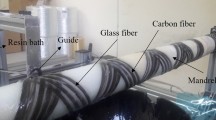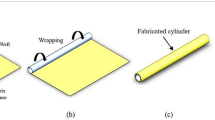Abstract
The present work is concerned with the improvement of crashworthiness characteristics of glass fiber-reinforced composite pipes (GFRP) by developing a trigger mechanism through circular cut-outs. To induce progressive crushing of the GFRP samples, circular cut-outs with varied geometrical designs in terms of number, position, and diameter were used. The wet filament winding process was used to fabricate the GFRP samples with±(55°)6 fiber orientation, which were then subjected to quasi-static axial compression test. The influence of cut-outs on the stability and fracture characteristics in a crash event was studied by analyzing the crashworthiness parameters such as load–displacement response, failure modes, crushing load efficiency, and energy absorption. Overall, the best performance for GFRP subjected to axial crushing was achieved from the samples having three cut-outs with the size of 10 mm diameters which are placed near to the impacted end.













Similar content being viewed by others
References
World Health Organization (2018) Global status report on road safety 2018: summary (No. WHO/NMH/NVI/18.20). World Health Organization
Ferdynus M, Rozylo P, Rogala M (2020) Energy absorption capability of thin-walled prismatic aluminum tubes with spherical indentations. Materials 13(19):4304
Ren Y, Jiang H, Liu Z (2019) Evaluation of double-and triple-coupled triggering mechanisms to improve crashworthiness of composite tubes. Int J Mech Sci 157:1–12
Zhang T, Liu TG, Xiao HL, Yu XF (2006) Energy absorption performance of thin-walled structures with triggering holes subjected to high-speed axial impact. Explosion Shock Waves 26(5):395
Yuen S, Nurick GN (2008) The energy-absorbing characteristics of tubular structures with geometric and material modifications: an overview. Appl Mech Rev 61(2)
Song HW, Du XW, Zhao GF (2002) Energy absorption behavior of double-chamfer triggered glass/epoxy circular tubes. J Compos Mater 36(18):2183–2198
Tong Y, Xu Y (2018) Improvement of crash energy absorption of 2D braided composite tubes through an innovative chamfer external triggers. Int J Impact Eng 111:11–20
Siromani D, Henderson G, Mikita D, Mirarchi K, Park R, Smolko J, Awerbuch J, Tan TM (2014) An experimental study on the effect of failure trigger mechanisms on the energy absorption capability of CFRP tubes under axial compression. Compos A Appl Sci Manuf 64:25–35
Jiang H, Ren Y (2019) Crashworthiness and failure analysis of steeple-triggered hat-shaped composite structure under the axial and oblique crushing load. Compos Struct 229:111375
Liu H, Falzon BG, Dear JP (2019) An experimental and numerical study on the crush behaviour of hybrid unidirectional/woven carbon-fibre reinforced composite laminates. Int J Mech Sci 164:105160
Flesher ND, Chang FK, Janapala NR, Starbuck JM (2011) A dynamic crash model for energy absorption in braided composite materials-Part II: Implementation and verification. J Compos Mater 45(8):867–882
Eshkoor RA, Oshkovr SA, Sulong AB, Zulkifli R, Ariffin AK, Azhari CH (2013) Effect of trigger configuration on the crashworthiness characteristics of natural silk epoxy composite tubes. Compos B Eng 55:5–10
Huang JC, Wang XW (2010) Effect of the SMA trigger on the energy absorption characteristics of CFRP circular tubes. J Compos Mater 44(5):639–651
Joosten MW, Dutton S, Kelly D, Thomson R (2010) Experimental evaluation of the crush energy absorption of triggered composite sandwich panels under quasi-static edgewise compressive loading. Compos A Appl Sci Manuf 41(9):1099–1106
Kindervater CM, Johnson AF, Kohlgrüber D, Lützenburger M, Pentecote N (2000) Crash and impact simulation of aircraft structures-hybrid and FE based approaches. In: European congress on computational methods in applied sciences and engineering. Barcelona, Spain: ECCOMAS
Jahani M, Beheshti H, Heidari-Rarani M (2019) Effects of geometry, triggering and foam-filling on crashworthiness behaviour of a cylindrical composite crash box. Int J Automotive Mech Eng 16(2):6568–6587
Käfer B, Bheemineni VK, Lammer H, Kotnik M, Riemelmoser FO (2013) Effects of position and cut-out lengths on the axial crushing behavior of aluminum tubes: experimental and simulation. Int J Civ Environ Eng 7(11):2157–2164
Chiu YS, Jenq ST (2014) Crushing behavior of metallic thin-wall tubes with triggering mechanisms due to quasi-static axial compression. J Chin Inst Eng 37(4):469–478
Rai V, Ghasemnejad H, Watson JW, Gonzalez-Domingo JA, Webb PF (2019) Developed trigger mechanisms to improve crush force efficiency of aluminium tubes. Eng Struct 199:109620
Mamalis AG, Manolakos DE, Ioannidis MB, Papapostolou DP (2005) On the crushing response of composite sandwich panels subjected to edgewise compression: experimental. Compos Struct 71(2):246–257
Palanivelu S, Van Paepegem W, Degrieck J, Van Ackeren J, Kakogiannis D, Van Hemelrijck D, Wastiels J, Vantomme J (2010) Experimental study on the axial crushing behaviour of pultruded composite tubes. Polym Testing 29(2):224–234
Özbek Ö, Bozkurt ÖY (2019) Hoop tensile and compression behavior of glass-carbon intraply hybrid fiber reinforced filament wound composite pipes. Mater Testing 61(8):763–769
Özkılıç YO, Yazman Ş, Aksoylu C, Arslan MH, Gemi L (2021) Numerical investigation of the parameters influencing the behavior of dapped end prefabricated concrete purlins with and without CFRP strengthening. Construct Build Mater 275:122173
Bulut M (2017) Mechanical characterization of Basalt/epoxy composite laminates containing graphene nanopellets. Compos B Eng 122:71–78
Madenci E, Özkılıç, YO, Gemi L (2020) Buckling and free vibration analyses of pultruded GFRP laminated composites: Experimental, numerical and analytical investigations. Compos Struct 254:112806
Uslu E, Gavgali M, Erdal MO, Yazman Ş, Gemi L (2021) Determination of mechanical properties of polymer matrix composites reinforced with electrospinning N66, PAN, PVA and PVC nanofibers: a comparative study. Mater Today Commun 26:101939
Özbek Ö, Bozkurt ÖY, Erkliğ A (2021) Effect of basalt intraply fiber hybridization on the compression behavior of filament wound composite pipes. Int Polym Proc 36(2):193–204
Oguz ZA, Erklig A, Bozkurt ÖY (2020) Degradation of hybrid aramid/glass/epoxy composites hydrothermally aged in distilled water. J Compos Mater 0021998320984237
Gemi DS, Şahin ÖS, Gemi L (2021) Experimental investigation of the effect of diameter upon low velocity impact response of glass fiber reinforced composite pipes. Compos Struct 114428
Maziz A, Tarfaoui M, Gemi L, Rechak S, Nachtane M (2021) A progressive damage model for pressurized filament-wound hybrid composite pipe under low-velocity impact. Compos Struct 114520
Gemi L, Madenci E, Özkılıç YO (2021) Experimental, analytical and numerical investigation of pultruded GFRP composite beams infilled with hybrid FRP reinforced concrete. Eng Struct 244:112790
Oğuz ZA, Erkliğ A, Bozkurt ÖY (2021) Effects of hydrothermal seawater aging on the mechanical properties and water absorption of glass/aramid/epoxy hybrid composites. Int Polym Proc 36(1):79–93
Chiu LN, Falzon BG, Ruan D, Xu S, Thomson RS, Chen B, Yan W (2015) Crush responses of composite cylinder under quasi-static and dynamic loading. Compos Struct 131:90–98
Tan W, Falzon BG, Price M (2015) Predicting the crushing behaviour of composite material using high-fidelity finite element modelling. Int J Crashworthiness 20(1):60–77
Özbek Ö, Bozkurt ÖY, Erkliğ A (2019) An experimental study on intraply fiber hybridization of filament wound composite pipes subjected to quasi-static compression loading. Polym Testing 79:106082
Farley GL, Jones RM (1992) Crushing characteristics of continuous fiber-reinforced composite tubes. J Compos Mater 26(1):37–50
Cui Z, Liu Q, Sun Y, Li Q (2020) On crushing responses of filament winding CFRP/aluminum and GFRP/CFRP/aluminum hybrid structures. Compos Part B Eng 200:108341. Kompozit crush
McGregor C, Vaziri R, Poursartip A, Xiao X (2016) Axial crushing of triaxially braided composite tubes at quasi-static and dynamic rates. Compos Struct 157:197–206. Kompozit crush
Özbek Ö, Doğan NF, Bozkurt ÖY (2020) An experimental investigation on lateral crushing response of glass/carbon intraply hybrid filament wound composite pipes. J Braz Soc Mech Sci Eng 42(7):1–13
Wang Y, Feng J, Wu J, Hu D (2016) Effects of fiber orientation and wall thickness on energy absorption characteristics of carbon-reinforced composite tubes under different loading conditions. Compos Struct 153:356–368
Roslan MN, Yahya MY, Ahmad Z, Abdul Rashid AH, Wang WX (2018) Energy absorption capacity of basalt sandwich composite cylinder subjected to axial compression loadings. In: Materials science forum (vol 917, pp 7–11). Trans Tech Publications Ltd
Elgalai AM, Mahdi E, Hamouda AMS, Sahari BS (2004) Crushing response of composite corrugated tubes to quasi-static axial loading. Compos Struct 66(1–4):665–671
Liu Q, Xing H, Ju Y, Ou Z, Li Q (2014) Quasi-static axial crushing and transverse bending of double hat shaped CFRP tubes. Compos Struct 117:1–11
Hu D, Zhang C, Ma X, Song B (2016) Effect of fiber orientation on energy absorption characteristics of glass cloth/epoxy composite tubes under axial quasi-static and impact crushing condition. Compos A Appl Sci Manuf 90:489–501
Sivagurunathan R, Way SLT, Sivagurunathan L, Yaakob MY (2018) Effects of triggering mechanisms on the crashworthiness characteristics of square woven jute/epoxy composite tubes. J Reinf Plast Compos 37(12):824–840
Jimenez MA, Miravete A, Larrode E, Revuelta D (2000) Effect of trigger geometry on energy absorption in composite profiles. Compos Struct 48(1–3):107–111
Song Z, Ming S, Li T, Du K, Zhou C, Wang B Improving the energy absorption capacity of square CFRP tubes with cutout by introducing chamfer. Int J Mech Sci 189:105994
Huang J, Wang X (2010) On a new crush trigger for energy absorption of composite tubes. Int J Crashworthiness 15(6):625–634
Peters ST (ed) (2011) Composite filament winding. ASM International
ASTM D2584 (2002) Standard test method for ignition loss of cured reinforced resins. In: American Society for Testing and Materials (vol 100)
Ramakrishna S, Hamada H (1998) Energy absorption characteristics of crash worthy structural composite materials. In: Key engineering materials (vol 141, pp 585–622). Trans Tech Publications Ltd
Palanivelu S, Van Paepegem W, Degrieck J, Vantomme J, Kakogiannis D, Van Ackeren J, Van Hemelrijck D, Wastiels J (2011) Crushing and energy absorption performance of different geometrical shapes of small-scale glass/polyester composite tubes under quasi-static loading conditions. Compos Struct 93(2):992–1007
Gupta NK, Gupta SK (1993) Effect of annealing, size and cut-outs on axial collapse behaviour of circular tubes. Int J Mech Sci 35(7):597–613
Zhang XW, Tian QD, Yu TX (2009) Axial crushing of circular tubes with buckling initiators. Thin-walled Struct 47(6–7):788–797
Toda S (1983) Buckling of cylinders with cutouts under axial compression. Exp Mech 23(4):414–417
Author information
Authors and Affiliations
Corresponding author
Additional information
Technical Editor: João Marciano Laredo dos Reis.
Publisher's Note
Springer Nature remains neutral with regard to jurisdictional claims in published maps and institutional affiliations.
Rights and permissions
About this article
Cite this article
Özbek, Ö., Bozkurt, Ö.Y. & Erkliğ, A. Development of a trigger mechanism with circular cut-outs to improve crashworthiness characteristics of glass fiber-reinforced composite pipes. J Braz. Soc. Mech. Sci. Eng. 44, 15 (2022). https://doi.org/10.1007/s40430-021-03304-x
Received:
Accepted:
Published:
DOI: https://doi.org/10.1007/s40430-021-03304-x




